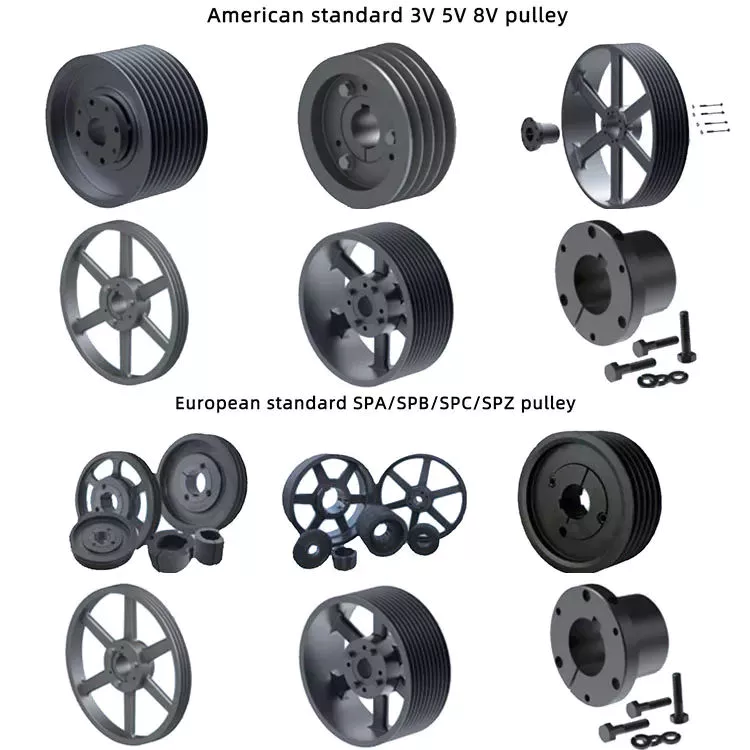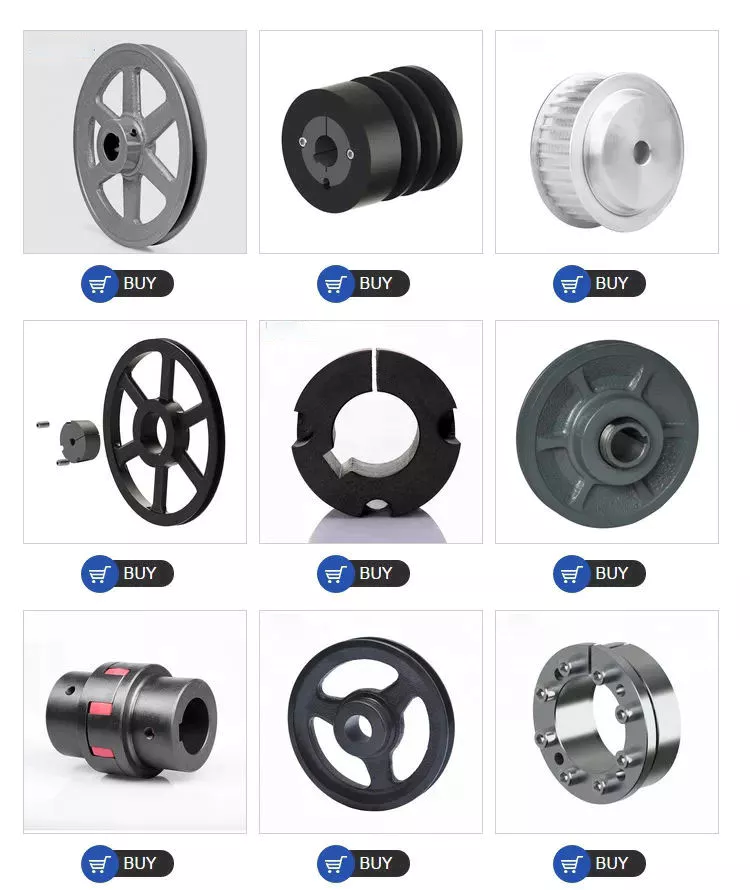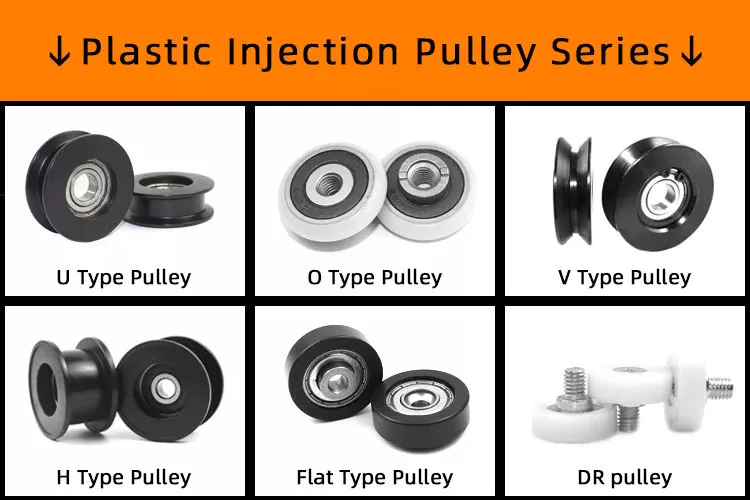Productomschrijving
Factory high quality Aluminum alloy 5mm bore 2 flanges GT2 GT3 GT5 GT8 GT14 timing belt pulleys
1) Garantie: our timing pulley's quality is very good and with ensurance within 1 year, when you receive the products and find quality problems, we promise you could return it back and free maintenance.
2) Drawings: please send you timing pulleys' drawings to us to get the best quotation; If you have no drawings, then we could work out CAD drawings and the best quotation to you ASAP.
3) Sample: we accept 1 piece sample's order, we could do samples until you're satisfied.
4) Confidentiality agreetment: Strictly adherence to client confidentiality agreetment for timing pulleys.
| Product Description |
|
Product Name |
Timing Belt Pulley | |
| Teeth profile | Trapezoidal toothed | MXL, XXL, XL, L, H, XH, XXH |
| T-toothed | T2.5, T5, T10, T20 | |
| Arc toothed | HTD3M, HTD5M, HTD8M, HTD14M, HTD20M, Gt2, Gt3, Gt5 | |
| S-toothed | S2M, S3M, S4.5M, S5M, S8M, S14M | |
| Parabolic-toothed | P2M, P3M, P5M, P8M, P14M | |
| Y-toothed | G2M, G3M, G5M, Y8M | |
| Teeth Quantity | 10-150 teeth or customized | |
| Inner Bore | 2-200mm H7 precision or customized | |
| Belt width | 4mm, 6mm, 9mm, 10mm, 12mm, 15mm, 20mm, 25mm, 30mm, 40mm, 50mm, 1/4”, 5/16”, 3/8”, 1/2”, 3/4”, 1”, 1.5”, 2”or customized | |
| Accessories | We can provide the service of assembling setscrews, bearings, shafts or taper bush | |
| Surface treatment | Anodize,Black Oxide,Phosphate and Galvanization | |
| Drawing Format | Timing belt pulley cad drawing,timing belt pulley UG drawing,Timing belt Pulley Soliwork drawing,Timing Pulley PDF drawing | |
What is timing pulley?
Timing pulleys are specialized pulleys that have either teeth or pockets around the outside diameter of the pulley body. Timing teeth engage holes in the metal belt, while timing pockets engage drive lugs on a belt's inner circumference. These teeth or pockets are used only for timing, not for power transmission.
How timing pulleys work?
The synchronous wheel transmission is composed of an endless belt with equal-spaced teeth on the inner peripheral surface and a pulley with corresponding teeth. During operation, the toothed teeth mesh with the tooth grooves of the pulley to transmit motion and power, which is integrated with the belt. A new type of belt drive with the advantages of transmission, chain drive and gear transmission.
What is gt2 timing pulley?
2mm pitch GT2 Pulley. The GT2 or 2GT Tooth Profile timing pulley prevails in the 3d printing hobby cause the Round tooth profile brings high precision of non-backlash, were known as today's Reprap Pulley.
What is a timing pulley flange?
Timing pulley flanges are used to maintain belt contact with a timing pulley in power transmission applications.Timing pulley flanges are manufactured to fit timing pulleys of the same pitch and size. The dimensions of a pitch, including the mating flange, are specified by the number of grooves.
What are synchronous belts used for?
The trapezoidal tooth profile first used on synchronous belts is recognized as standard. Belts with this configuration are commonly used in machine tools, textile machinery, home appliances, business equipment, and as camshaft drives in engines.
Note:Please confirm you need teeth profile, teeth quantity, belt width, bore diameter, quantity and type (please refer below drawings) to get our the most complete CAD drawings and the best quotation.
Related Products
| Certificering: | ISO |
|---|---|
| Katrolmaten: | Type F |
| Productieproces: | Forging |
| Materiaal: | Ijzer |
| Oppervlaktebehandeling: | Baking Paint |
| Sollicitatie: | Chemische industrie, graantransport, mijnbouwtransport, elektriciteitscentrale |
| Voorbeelden: |
US$ 50/Piece
1 stuk (min. bestelling) | |
|---|
| Aanpassing: |
Beschikbaar
| Aangepast verzoek |
|---|

Can pulleys be used in both simple and complex mechanical systems?
Yes, pulleys can be used in both simple and complex mechanical systems. Pulleys are versatile mechanical devices that can be incorporated into a wide range of systems to transmit power, change direction, or provide mechanical advantage.
In simple mechanical systems, pulleys are often used to create a mechanical advantage by reducing the effort force required to lift or move a load. For example, a simple pulley system with a single fixed pulley can distribute the load's weight over multiple strands of rope or cable, reducing the force needed to lift the load. Simple pulley systems are commonly used in applications such as flagpoles, well buckets, or manual hoists.
In more complex mechanical systems, pulleys can be part of intricate arrangements to achieve specific functions. They can be combined with multiple pulleys, belts or ropes, and other mechanical components to create complex systems for power transmission, tensioning, or precise control. Examples of complex systems that utilize pulleys include conveyor belt systems, industrial machinery, cranes, and elevators.
Pulleys offer several advantages in both simple and complex mechanical systems:
1. Mechanical Advantage: Pulleys can provide a mechanical advantage by distributing the load's weight over multiple strands of rope or belt, reducing the effort force required to lift or move the load.
2. Direction Change: Pulleys can change the direction of the force applied, allowing for redirection of motion or routing of belts or ropes around obstacles.
3. Speed Adjustment: By adjusting the size of pulleys and the number of pulley systems, the speed of the output motion can be modified relative to the input motion.
4. Power Transmission: Pulleys are effective in transmitting power between shafts or components, allowing for the transfer of rotational motion and torque.
5. Versatility: Pulleys can be used with different types of belts or ropes, such as flat belts, V-belts, timing belts, or wire ropes, providing flexibility in design and application.
Whether in simple or complex mechanical systems, the selection, arrangement, and sizing of pulleys should be carefully considered to ensure proper functionality, efficiency, and safety. Manufacturers' guidelines, engineering principles, and best practices should be followed when incorporating pulleys into mechanical systems.

Waarom is het belangrijk om de poelie goed uit te lijnen en op spanning te brengen?
Juiste uitlijning en spanning van de katrol zijn cruciale factoren om de efficiënte en betrouwbare werking van katrolsystemen te garanderen. Ze spelen een belangrijke rol bij het maximaliseren van de krachtoverbrenging, het minimaliseren van slijtage en het behouden van de algehele prestaties en levensduur van het systeem. Hier is het belang van juiste uitlijning en spanning van de katrol:
1. Efficiëntie van krachtoverbrenging:
Proper pulley alignment and tensioning ensure optimal power transmission efficiency. When pulleys are misaligned or belts/chains are improperly tensioned, energy is wasted due to increased friction and slippage. This results in decreased power transfer and reduced system efficiency. By aligning the pulleys parallel to each other and applying the correct tension to the belts or chains, the system can achieve maximum power transmission, minimizing energy losses.
2. Levensduur van de riem/ketting:
Correcte uitlijning en spanning van de poelie dragen bij aan de levensduur van riemen en kettingen. Verkeerde uitlijning en onvoldoende spanning kunnen ongelijkmatige slijtage, overmatige rek en voortijdig falen van de riemen of kettingen veroorzaken. Correcte uitlijning en spanning verdelen de belasting gelijkmatig over de riemen of kettingen, waardoor de spanning wordt verminderd en hun levensduur wordt verlengd. Dit helpt om ongeplande uitvaltijd, onderhoudskosten en de noodzaak voor frequente vervanging van riemen/kettingen te voorkomen.
3. Minder lawaai en trillingen:
Onjuiste uitlijning en spanning van de katrol kan leiden tot meer lawaai en trillingen in het systeem. Verkeerd uitgelijnde katrollen of losse riemen/kettingen kunnen overmatige trillingen veroorzaken, wat resulteert in lawaai, schade aan apparatuur en ongemak voor operators of personeel in de buurt. Juiste uitlijning en spanning helpen trillingen te minimaliseren, wat zorgt voor een stillere werking en een comfortabelere werkomgeving.
4. Systeembetrouwbaarheid en veiligheid:
Juiste uitlijning en spanning dragen bij aan de algehele betrouwbaarheid en veiligheid van katrolsystemen. Verkeerd uitgelijnde katrollen of losse riemen/kettingen kunnen leiden tot onverwachte storingen, defecten of ongelukken. Te veel spanning kan ook leiden tot overmatige spanning op componenten en het risico op systeemstoringen vergroten. Door de juiste uitlijning en spanning te handhaven, werkt het systeem binnen de ontwerpparameters, waardoor de kans op onverwachte storingen wordt verkleind en de veiligheid van operators en apparatuur wordt gewaarborgd.
5. Verbeterde prestaties:
Correcte uitlijning en spanning van de poelie verbeteren de algehele prestaties van het systeem. Correct gespannen riemen of kettingen bieden betere grip en tractie, wat zorgt voor een soepelere en nauwkeurigere beweging van de aangedreven componenten. Dit resulteert in een verbeterde snelheidsregeling, minder slippen en een grotere nauwkeurigheid in toepassingen zoals transportsystemen, machinegereedschappen en automotoren.
6. Onderhoud en kostenbesparing:
Correcte uitlijning en spanning van de poelie kan leiden tot aanzienlijke onderhouds- en kostenbesparingen. Goed uitgelijnde poelies en correct gespannen riemen of kettingen ervaren minder slijtage en vereisen minder aanpassingen. Dit vermindert de frequentie van onderhoudstaken, zoals het vervangen van riemen/kettingen, opnieuw uitlijnen en opnieuw spannen. Bovendien helpen correcte uitlijning en spanning, door de efficiëntie van de krachtoverbrenging te maximaliseren en slijtage te minimaliseren, het energieverbruik te verminderen en de bedrijfskosten te verlagen.
Concluderend zijn de juiste uitlijning en spanning van de katrol cruciaal voor het bereiken van optimale efficiëntie van de krachtoverbrenging, het verlengen van de levensduur van riemen of kettingen, het verminderen van geluid en trillingen, het garanderen van de betrouwbaarheid en veiligheid van het systeem, het verbeteren van de prestaties en het realiseren van onderhouds- en kostenbesparingen. Het is essentieel om de richtlijnen van de fabrikant te volgen en regelmatig inspecties en aanpassingen uit te voeren om de juiste uitlijning en spanning in katrolsystemen te behouden.

What are the advantages of using pulleys for mechanical advantage?
Using pulleys for mechanical advantage offers several advantages in various applications. Here are the key advantages:
1. Increased Lifting Capacity: One of the primary advantages of using pulleys for mechanical advantage is that they allow for the lifting of heavier loads with less effort. By distributing the load over multiple segments of rope or belt, pulleys reduce the amount of force required to lift the load. This is especially beneficial in scenarios where manual lifting or limited power is involved.
2. Easier Load Manipulation: Pulleys make it easier to manipulate and control heavy loads. The mechanical advantage provided by pulleys reduces the force needed to move or lift the load, allowing operators to exert less effort. This makes tasks such as lifting, lowering, and positioning heavy objects more manageable and less physically demanding.
3. Safety and Injury Prevention: By reducing the amount of force required to lift heavy loads, pulleys contribute to improved safety and injury prevention. When operators have to exert less physical effort, the risk of strains, sprains, and other lifting-related injuries is significantly reduced. Pulleys enable controlled and smoother load movement, minimizing the risk of sudden shifts or drops that could cause accidents.
4. Precise Load Positioning: Pulley systems provide precise control over load positioning. By using multiple pulleys and adjusting the tension in the rope or belt, operators can achieve precise vertical and horizontal movements of the load. This level of control is particularly valuable in applications that require accurate placement of heavy objects, such as construction, manufacturing, and material handling.
5. Versatility and Adaptability: Pulleys offer versatility and adaptability in various applications. They can be configured in different arrangements and combinations to achieve specific mechanical advantages based on the requirements of the task or load. Pulleys can be easily integrated into existing systems or incorporated into custom-designed setups, making them highly adaptable to different situations.
6. Efficient Power Transmission: Pulleys provide efficient power transmission in mechanical systems. They enable the transfer of rotational motion and force from one component to another with minimal energy loss. The use of pulleys allows for the optimization of power transmission, ensuring effective utilization of available power sources.
7. Cost-Effectiveness: Using pulleys for mechanical advantage can be cost-effective compared to alternative methods. Pulleys are relatively simple and economical devices that can be readily obtained. They require minimal maintenance and have a long operational lifespan. Additionally, pulley systems can often be designed and implemented without the need for complex and expensive equipment.
In conclusion, using pulleys for mechanical advantage offers advantages such as increased lifting capacity, easier load manipulation, safety and injury prevention, precise load positioning, versatility, efficient power transmission, and cost-effectiveness. These advantages make pulleys a valuable tool in a wide range of industries and applications.


redacteur door CX
2023-12-15
